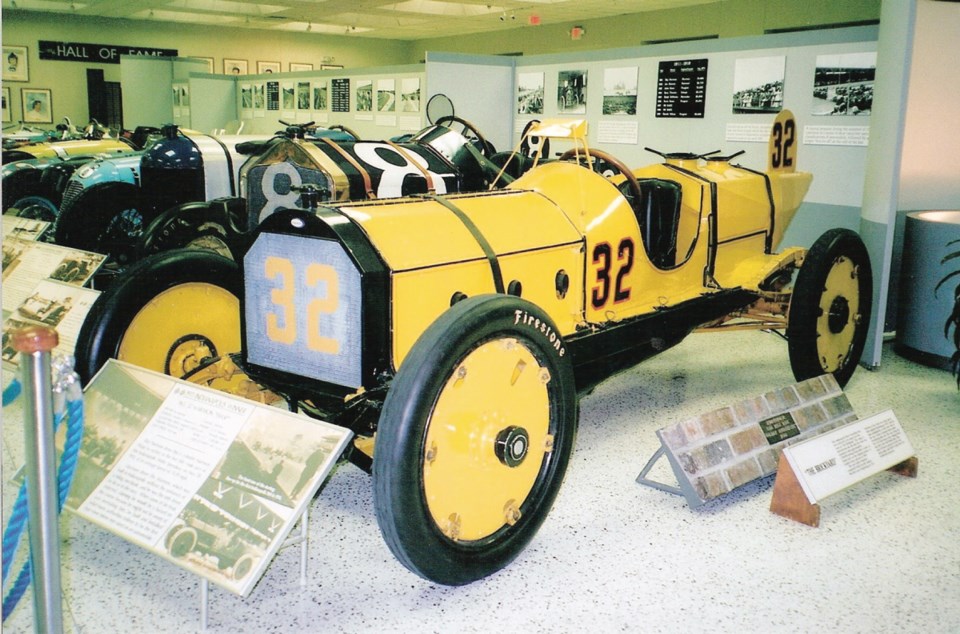The Indianapolis 500 mile race has been held every year since 1911, except for six years during the First and Second World Wars. This Greatest Spectacle in Sport runs on Memorial Day in May.
The track was the brainchild of Carl Fisher, car dealer and founder of Prest-O-Lite headlamp company, and three other Indianapolis automotive executives. It was conceived as a proving ground and racing facility for auto manufacturers to test and demonstrate their cars’ speed and endurance.
It emerged in Indianapolis, not Detroit, because Indianapolis and Indiana were then the American auto industry’s home for more than 100 manufacturers, including Auburn, Cord, Duesenberg, Marmon, Studebaker and Stutz.
The expanse of the speedway made it an awesome project. It was a 2-1/2 mile (4 km) “square oval” with two long and two short straights connected by four corners. It was constructed on a farm purchased a few miles northwest of downtown Indianapolis.
The track’s straights are 50 feet wide and 60 feet on the corners. Banking is 16.6 degrees, except the outer 10 feet, which is 36 degrees to redirect spinning cars back onto the track. Maximum design speed was less than 161 kilometres per hour (100 mph).
Construction began in March 1909 with the first race scheduled for August. For economy, the track was constructed of tar and gravel, not asphalt, and it was unique in the world.
The first three-day racing meet (not the 500) in August 1909 was a bloody affair. The track rutted quickly and gravel flew like shrapnel. The sanctioning American Automobile Association stopped Sunday’s 300 mile (483 km) finale at the 378 km (235 mile) mark. The death toll: one driver, two mechanics and two spectators.
The press was merciless, calling for an auto racing ban. In spite of the severe criticism Fisher persisted with a promise to improve the surface. He had it paved with bricks late in 1909, hence the track’s “Brickyard” nickname.
A few events were held in 1910 but Fisher’s big plan was for 1911: a 500-mile (805 km) contest, “The greatest automobile race in the history of the industry.” With a purse of $25,000 it was open to any manufacturer in the world. When 80,000 fans showed up the Indy 500 tradition was born.
The American and foreign racers were little more than stripped stock cars powered by huge engines with extra tuning for a little more speed and durability. Many were entered by factories seeking publicity.
The usual racing crew was a driver and riding mechanic/ observer, but there was one exception. Ray Harroun, a Marmon engineer driving a Marmon Model 32 received reluctant approval to dispense with the riding mechanic. He built a single seat body on the Marmon and mounted a small mirror on top of the cowl; it was the first use of such a device.
To prevent the danger of 40 cars trying to accelerate together, they cruised around the track in formation at 64 km/h. They did a rolling start behind the pace car until flagged off at the start/finish line.
All went well until near the race’s mid-point when a car wrecked and struck the judges’ stand causing race scorers to scramble for safety. This naturally disrupted race scoring.
The scoring was finally restored and at the end Ray Harroun, assisted by relief driver Cyrus Patschke, was declared the winner in the Marmon Wasp named for its yellow colour and long pointed tail.
Protests were immediately filed, causing AAA officials to withhold their decision on the other positions until the next day to do further checking. When the controversial results were announced, the finishing order was Harroun, Ralph Mulford in a Lozier and David Bruce-Brown in a Fiat. All lap scoring records mysteriously disappeared.
Harroun’s winning Marmon was powered by a 7.8 litre six cylinder, 110 horsepower T-head engine (intake valves on one side and exhausts on the other operated by two camshafts). It would reach close to 161 km/h and Harroun’s average was 120 km/h. He took home $14,000 for his victory, and left the rearview mirror as his lasting legacy.
Harroun, a brilliant engineer, wisely retired from racing after his win. He became chief engineer at Marmon but soon left to manufacturer a carburetor he invented. He designed a car, the Harroun, which was built from 1917 to 1922. He also worked for Chrysler Corp. and others. The Marmon Co. ceased car production in 1933.
On the Indy 500’s 50th anniversary, 83-year -old Harroun came out of “racing retirement” to drive his original winning Marmon around the track.
He died in 1968 at age of 89. His winning Wasp is on display in the Indianapolis Motor Speedway Museum.



